#Terry follows cartoon logic
Explore tagged Tumblr posts
Text
Guys. I need your opinions on something. Yes it's important.
Ok ok ok yes huddle around huddle around. So, first I'm gonna present what I think isn't particularly controversial and I myself feel pretty confident about which is this:

You might even put Sparrow further to the left idk. Then there's what I think some people will definitely disagree with but I myself feel strongly about (in me bones) and that's this:

But that's where I'm at a loss. Grant and Nicky I mean, they're enigmas to me (in this specific but definitely important case scenario). I keep moving them around and changing my mind.
SO. Thoughts??? Opinions??? It's for science.
#I'm in such a dumb mood I'm so sorry but I so genuinely want people's opinions on the matter LOL PLEASE#dndads#yes this too will go in the main tag#sparrow oak garcia#lark oak garcia#terry jr.#to some extent it was Thrush's post with Glenn and Ron that got me thinking about this yesterday lmao#I think it's a good scale tbh#Sparrow follows soap opera logic#Terry follows cartoon logic#get you a man who can do both (Lark)
82 notes
·
View notes
Text
Thoughts about each TDI Reboot episode, starting at 1. SPOILERS UNDER THE READMORE.
Chris' new voice is certainly... a change. I don't mind it, and I think Terry is getting his acting and emotes for him right, but it's definitely gonna take some time to adjust and not immediately think it's Don.
"Hey, what's up I'm here to slay" from the intro is killing me in the best and worst ways. Rip the old intro song.
Also there's a very VERY small detail for the campfire. When Raj looks back to the screen, only one of his eyes follow. Either an animation error, or he has a lazy eye.
It's been 15 years since the beginning of the show in canon?? That means the gen 1 and 2 casts are roughly between 28-31 I think?? And yet Chris and Chef Hatchet don't look any different. Also since og Island premiered in 2007, this one is taking place in 2022 and NOT 2023.
Either way this gives me a good excuse to practice character design with a 15 years timeskip and make adult designs for the gen 1 and 2 casts.
Priya. WHAT. GIRL GO TO THERAPY AND GET AWAY FROM YOUR PARENTS. Also Owen cameo.
Bowie is gay like I thought he'd be. Now way he wasn't a reference to David Bowie. Getting some vibes of him being the new Heather tbh.
I, like many others, thought Ripper was going to be the new Owen. He's only a small bit Owen with a dash of Duncan, and a whole lot of Scott. Respect to Ripper for how spicy he likes his food, tho lol.
Chase and Emma are exes. Chase is a YouTube/Twitch personality T-T. Here's hoping that Emma broke up with him bc she's a lesbian. Really want her and Bowie to be besties.
Scary Girl's real name is Lauren >:(
Zee is both the smartest and dumbest character. I want him to be the blorbo of the season, but I'm getting the feeling it's gonna be Bowie.
Wayne: "What'd you think, Rajey?" 🥺
Nichelle is the only one to not get an audition tape. Interesting. Also a Madonna reference?
Julia called herself an influencer. She better be an early boot for that.
MK, Axel, Caleb and Damien are the only ones I don't have any comments about. Sucks 'cause I was hoping I'd really like MK and Axel.
Drone of Dispair. Somehow the worst idea yet lol. Can't wait for a joke about one of the contestants flying over private airspace and getting shot.
Ripper called himself the alpha male nooooo
EVEN BOWIE IS CALLING WAYNE AND RAJ GAY LMAO
And Bowie immediately goes to the girls' side of the cabin to talk shit about Chase with Emma. Love them sm.
Ripper: "Where'd you get the soda from??"
Zee: "...I have no idea."
Rip Bowie's heart glasses, hope cartoon logic kicks in and he has a million of then.
If Damien thinks they can't show Ripper's censored ass on TV, then I wonder what his reaction would be to a show like Naked and Afraid.
Emma and Chase didn't break up over lesbianisms unfortunately. But messing up her car's breaks and causing her to crash is still a valid reason for her to break up with him and be incredibly upset. Like, he could have killed her, other bystanders, or any of the puppies at the shop she crashed into. Yet I think the show is treating Emma as being unreasonable? It's just a prank bro.
Also MK calling Emma out for saying 25% of the money instead of half like she did when talking to Bowie earlier. Maybe there's more to the break up story?? Like she's lying?? But that still wouldn't make sense if the show is already treating her as unreasonable beforehand. Idk.
Bowie really do be like "are the straights okay? 🙄"
Raj: "Wayners" 😭
Also Wayne and Raj both have the same accent as Ezekiel.
Goodbye Caleb, we barely knew ya. Have fun hanging out with Staci and getting no character development like her. Maybe one day he can come back like Justin.
BOWIE IS THE NEW HEATHER, I WAS RIGHT AND HE IS GONNA BE THE BLORBO
Overall, fun first episode. Not a smash hit or anything, but a pretty good hook. Also the animation and character design is such an upgrade. I was hesitant about the new cast's designs, but actually seeing them in the show and moving makes it work so much better to me. After rewatching the first half of og Island, it is amazing to see how far this show and its animators have come from 2007.
2 notes
·
View notes
Text
Speed Racer (2008)

I can understand why Speed Racer wasn't well-received in 2008. Having heard only negative things, I sat down with it fully expecting a catastrophe. It isn't. I’m not going to go so far as call it visionary, but it's certainly bold in its structure, visuals and direction. Like many of the Wachowski’s films, it has a lot to offer and if you go in with an open mind, you’ll be pleasantly surprised. You may even love it.
Based on the television series of the same name, itself based on the manga by Tatsuo Yoshida, 18-year-old Speed Racer (Emile Hirsch) has been obsessed with racing his entire life. After his brother dies during the Casa Cristo 5000, Speed embarks on his own racing career when he is approached by E.P. Arnold Royalton (Roger Allam), owner of conglomerate Royalton Industries. Speed declines the corporation’s luxurious offers and now, the family must band together to win the Grand Prix, or lose everything to the corporate giant.
If there had been even a drop of cynicism in the 135-minute running-time, Speed Racer would've crashed and burned. Like its protagonist, the film is determined to see itself through. This picture is wild even before we get to the unusual editing, story and structure. Speed’s parents (Susan Sarandon and John Goodman) run an independent company called Racer Motors along with their youngest son, Spritle (Paulie Litt) and his pet chimpanzee Chim Chim. You’d expect the kid sidekick and his monkey to be cheap comic relief, but they’re integral parts of the story. They're never annoying because their presence never hinders Speed. Also living in their home is their mechanic Sparky. No one is ever taken aback by this or the various costumed racers participating in the multiple races seen throughout. It makes for a bizarre kind of world with its own logic you just get into. After the initial shock settles, you're surprised that the seemingly simple relationships and characters expands as the film goes. The whole thing is a cartoon, but what a cartoon it is.
Once Speed gets into his Formula One car and puts the pedal to the metal, it’s like he’s driving down that corridor of light at the end of 2001: A Space Odyssey. It’s a dazzling, dizzying burst of twists, turns and sweeps so incredible they’re nearly overwheleming. It moves so fast you wish you could slow it down and catch everything, but the fact that you can’t is what makes it fantastic. The Wachowskis have thrown the rulebook on how to make a racing movie out of the window and by leaving the beaten path, they’ve reinvented moving vehicles on-screen with Speed Racer.
For the three impossible, big, flashy courses featured, the picture is worth seeing but there’s much more for you here. It’s unconventional, at times a little bit too wild, but when placed in this world that looks like a cross between a Terry Gilliam project and Lazytown, you accept it. The film is packed to the brim with moments that further develop the relationship between Speed and his family but never at the expense of the white-knuckle racing. A perfect example is in the very first competition. Speed gets so far ahead of his competitors he come face-to-face with his brother’s ghost. Not a spirit; a digital hologram of the best driver who’s ever been on that track. In the moments that follow, we learn how good Speed is at driving by comparing him to the record holder. We see how long the record has held so we understand just how big a deal it is. We get a display unlike any we’ve seen before and come to understand how much Speed respects, misses, admires and loves his brother all at once.
Speed Racer displays such imagination in its structure and racing sequences. While the film is sometimes difficult to follow because of its no-holds-barred approach, I think it may be one of the best racing film’s I’ve ever seen. (On DVD, April 7, 2018)
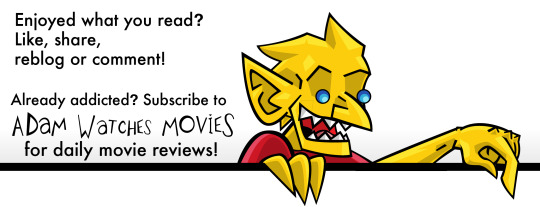
#Speed Racer#movies#films#movie reviews#film reviews#The Wachowskis#Emile Hirsch#Christina Ricci#John Goodman#Susan Sarandon#Matthew Fox#Benno Furmann#Hiroyuki Sanada#Rain#Richard Roundtree#2008 movies#2008 films
3 notes
·
View notes
Note
I know you're a blackfyre stan (THE Blackfyre stan, really), but are there any Targaryens that you do like, besides the wonderful Daena?
I'll take that as a compliment (although I consider myself more of a regular fan than a “stan”). While there do seem to be more Blackfyre fans on the Westeros Forums or Tower of the Hand than on Tumblr, even on this site I'm far from the only one, or even the only one who writes meta. A 2015 Reddit poll indicates that House Blackfyre is among the top 20 favorite ASOIAF houses, which, given that the members of House Blackfyre don't appear in the main series, are mentioned in only one of the supplementary books (The World of Ice and Fire), and only one member appears in one Dunk and Egg novella, is actually very impressive. They rank higher than Houses Blackwood and Velaryon, two of GRRM's most glorified houses in the supplementary material. Their favorability despite few canon appearances proves that GRRM doesn't need to prop them up with improbable marriages to his most popular houses (Stark, Lannister, Baratheon, or Targaryen), or to have unrealistically successful heroes (like 12 year old expert generals) whose atrocities (burning smallfolk septs or sexually preying on multiple teenagers as a middle aged man) aren't condemned in the narrative. Rather, he gave them potential to be compelling characters who try to do the right thing against a corrupt government that has to commit war crimes to stay in power, that question the validity of the Targaryen legacy in a post-dragon world, that get betrayed by people who aren't shown to be 2D cartoon villains, whose faults (even the imagined ones) are (overly) called out by the narrative, are tragic in that they are shown to be honorable or talented people but pursue a goal that kills them, or that try hard to succeed despite their physical or mental disadvantages.
Which segues in to the next part of your question: if there are any Targaryen characters I like besides Daena:
If you had asked me this before Fire and Blood came out, I would've had an easier time answering! I might've said something like: Visenya, Aegon I, Queen Alyssa, Queen Rhaena, Alysanne, Rhaenys the Queen who Never Was, Helaena, Daeron the Daring, Aegon III, Jaehaera, Baela the Burnt, Daeron I, Elaena, Rhaena the Septa, Queen Aelinor, Prince Daeron son of Aegon V, and Rhaella. Then Fire and Blood was published, and it actually made the characters less interesting, deep, or likable with its greater word count. My sometime collaborator fury-burns said it best in that it was world unbuilding "that added unnecessary edginess to an already grim piece of writing". Whether it was not knowing how to write the much-hyped Aegon I as a compelling character, Visenya becoming bloodthirsty to the point of having few political allies and chastised by Aenys for her advice on dealing with the Faith, Queen Alyssa's abuse after her marriage to Robar, Rhaena retconned into a lesbian (she was clearly in love with Androw in The Sons of the Dragon and Elissa was nowhere in sight) who smothered her daughter into an early grave and spent her last years as a miserable "ghost" of Harrenhal, Alysanne who obeyed her husband in not seeing Saera and tried to protect her grown up son from "predations" by his 14-year-old sister, Rhaenys who married the 21-years-older Corlys Velaryon "for love" and was killed in the only battle she was ever mentioned participating in, Aegon III as Jaehaera's cruel bully who didn't even mourn her passing, or Baela who was retconned into being younger and not having visible burn scars in order to be a more palatable wife to GRRM's favorite Alyn Velaryon (I find this one the most offensive given what it indicates about his expectations for women) and then cuts the same man who saved her life across the face with a riding crop...well, Fire and Blood made me realize it wasn't so much the characters as GRRM had written them that I liked, but the potential I or other fans saw in them to be multifaceted like those in the main series. The characters that didn't do anything particularly heinous in-universe were massively watered down, sexist versions of amazing historical figures (I explain in a response post about Helaena vs Queen Mathilde of Boulogne), or abused for shock value/the anger of a male character.
I got my start in the fandom just before A Dance With Dragons came out, and consequently I was there when some truly great pre-canon fics were published. I have some fond memories as a teenager waiting in the library reading fanfics on Aegon and his sisters, Maegor and Aenys, or Baela and her family. Seeing their complicated, brilliantly written, memorable versions of the characters contradicted by the blatantly rushed, shallow, and plot-based characterization of Fire and Blood made me feel badly for the effort the fans put in that GRRM refused to (he actually hates all but some fanfiction). I understand creating characters with a backstory and have their actions flow logically from that backstory, and giving them an arc in which they develop, is difficult (and is really almost impossible through the format in which GRRM chose to write the supplemental books, which explains why he thinks it's easier to write) but the characters are why readers love the series. None of the characters in Fire and Blood can hold a candle to the complexity, the unique design, or the impressive character development of Theon Greyjoy, Jaime Lannister, Tyrion Lannister, Sansa Stark, Catelyn Stark, Stannis Baratheon, or Daenerys Targaryen. If he had written these characters like he did Fire and Blood, it would've been a forgettable, grimdark Tolkien rip-off along the lines of Terry G00dkind's L3gend of the S33ker.
Thus I'm holding off on saying I like any of the other Targaryen characters until GRRM is finished with them. The only ones from Fire and Blood that I still think are interesting and have some kind of compelling internal conflict (though I still don’t think they were written with their full potential, and could’ve used more development on their relationships) are Queen Visenya and Prince Daeron the Daring. Princess Elaena, Aelinor Penrose, and Ser Daeron in particular have the potential to be interesting, conflicted characters from the back half of the Targaryen reign, but I no longer trust GRRM to follow up on them in a meaningful way. Reading Fire and Blood also gave me more appreciation for the canon-era Targaryens Viserys and Daenerys, and how much more carefully written they are than their ancestors.
#ask#opinion#house Targaryen#asoiaf#grrm criticism#GRRM critical#characters#opinions#house blackfyre#fandom
31 notes
·
View notes
Note
What happens if Batman Beyond!Bruce used an android he controls through a cyber helmet to do the crime busting (after he used a gun to save himself from getting killed) during his 50's (years before he met Terry)?
i never thought I'd actually get an ask, so this is new but what've i got to loose? Sleep? (I actually forgot that I was answering this on phone notes for a few days 😰.)
Im gonna assume the gun part references the scene where Bruce picks up a gun, goes to use it, and is promptly horrified into retiring batman (if i remember correctly)? Well its already stated in, i think the cartoon, canon that bruce's tech is still way ahead of where Terry's generation of tech is when im assuming that canon!bruce would merely be providing upkeep on the battech not actually creating more up-to-date stuff. In keeping with that logic this means that any tech, android or otherwise, that bruce creates 20-30 years before Batman Beyond would vastly outpace pretty much anyone in gotham.
If bruce were able to create an android that he would be able pilot soley by using a helmet instead of an exoskeleton type setup or one of those suits balls/sensors that actors use (lets be real, DC has probably already done that somehow) that would allow him to still be a vigilante as long as he can keep his mind sharp and reflexes sharper. The android would need some kind of limited, and i mean very limited, AI system incase the signal gets disconnected. And at some point it will be cut off from bruce and he cant really afford the let that kind of tech to fall into the wrong hands, be they batman's villains or bruce wayne's business rivals or both. The android would the be able to assess the situation and figure out how to return to the cave without geing followed, but does it finish whatever situation it was in in the first place before it leaves? It would need to be able to analyze the situation and it would have to rely on any kind simulations that bruce provided it but lets be real here as smart and paranoid as bruce is he is literally unable to think of every kind of situation that could possibly happen to it.
Im not denying that the android would be useful, because it would be, but i also think that if it were truly an option then bruce would still become a recluse because, as canon says, by this point he has no one that he can rely on. Alfred is dead (rest in peace you magnificent butler), his first generation of batkids are out of the bat business and out of contact no matter which timeline you wanna look at and his second generation of batkid(s) isn't for another 20ish years. By this point in time hes already pushed the justice league away so he has no contact with them. Once he gives his company to Derek Powers the only reason he might have to leave his mansion is possibly charity events and hes getting old so he can get out of those easily.
no reason to leave his mansion? Check (food/grocery delivery)
No reason to leave the cave? Check
Sufficiently advanced technology for the time and the smarts to use it? Check
Batman is known but is still considered to be something of a myth and using an android to be his batman body would just increase the mythology surrounding batman. Before batman was just a human body and no matter how strong a human is they can only lift so much and go so long before their body rebels against them and drops. Now all he would have to worry about is how long his mind would be able to deal with piloting the android as long as he stays healthy. Batman also was susceptible to the various gases and poisons his villains are known for but if the android is on the streets and not the human body then that is one more thing that batman is now immune to.
Let's just face it Bruce Wayne is a paranoid bastard and he would do everything in his not inconsiderable power to make android!batman work. So batman would be around a lot longer but the question is how would he react when Terry comes along? For the sake of convenience let's just say that their meeting is still pretty much the same from canon; would bruce be able to give batman the suit to Terry or would bruce stay as batman the android?
This also supposes that bruce was able to overcome almost using a gun to kill when that was one of his rules: no guns and no killing.
2 notes
·
View notes
Text
Handicapping the 2020 Dem primary
Tier Four
The Tom Vilsack Memorial “No Chance in Hell” Tier
These are the candidates whose family members won’t even vote for them. They will drop out either before or immediately after Iowa. Some of them will be working specifically to plant the seeds of a 2024 run, while others are auditioning for an MSNBC gig.
Joe Kennedy

Any person who is simultaneously old enough and illiterate enough to have any fondness for the Kennedys is 100% in the Trump camp. Joe has zero appeal outside of this voting bloc, which literally does not exist. He won’t even win Massachusetts--won’t even be in the top five in Massachusetts.
Michael Avenatti

My man ain’t even announced his run and he’s already facing domestic assault charges. A potential Avenatti run had a mystical WWF vibe to it. I will admit, I was excited, the same as I’d be excited to finally pull alongside the accident that caused the pile up. No one has any idea what his policies are, because neither does he. He might honestly beat Trump in the general, as he is far and away the most likely candidate to physically assault Trump if the two ever share a stage (any Dem who punches Trump will be automatically 100% guaranteed to win the election). But he probably won’t even run.
Mitch Landrieu

Mitch will appeal to that small demographic of erstwhile independent voters who were drawn to Trump solely because he is an openly corrupt grifter. By May he will be a panel participant on a new MSNBC show that’s like Shark Tank but but all the contestants are trying to get the panel to fund their medical gofundme’s.
Eric Holder

Like every other member of the Obama administration, his faults are glaring and the relatively good stuff he did takes way too much context for most voters to understand. Under his leadership, the DoJ began began to litigate hate crimes, which had been almost completely neglected under Bush. That’s good. Also, under his leadership, the DoJ stalwartly refused to prosecute the war criminals who lied us into Iraq or the bankers who tanked the world economy. That’s bad. Politically, he has the platform of a Republican circa 1992. Personally, he has the charisma of a very dry snail.
Steve Bullock

He looks and sounds like the dumb guy sidekick of an old cartoon villain. He is therefore the Bebop/Rocksteady of the field. His policies are indistinguishable from any other civil moderate/fiscal conservative candidate, and his moistness will drive away both donors and media . (NOTE: With Bullock, the Avenatti Rule applies: if he threatens to physically assault Trump or any member of Trump’s family--especially including Baron--he will rocket to the top of the pack. If he actually assaults them, he will win the general election and usher in a glorious Centrist Utopia)
Kristen Gillibrand

She was once considered a front-runner for the same reason Corey Booker kinda sorta still is a frontrunner--because she looks similar to a previous Dem nominee, and many liberal strategists and commentators cannot conceive of a politics beyond identity markers. Trouble is, unlike Booker, Gillibrand pissed off her donor base by leading the the charge against Al Franken. I don’t for a second think that Gillibrand’s efforts had anything to do with principles. She just leaned into the wrong direction of the skid of cynicism: if there’s one thing Democrat donors hate, it’s a candidate who appears to adhere to any kind of moral framework. And Gillibrand is not the sort of candidate who stands a chance without full institutional support.
Tier Three
The “Gormless Dweebs” Tier
These people might stick around until late in the game for the same reason they’d stay at a house party until well after they were no longer welcome. Each also possesses a very particular strain of weirdness that might resonate with voters in New Hampshire enough that they’d finish in the top 3, but none has a realistic chance to live past Super Tuesday.
Martin O’Malley

O’Malley is the Democrat John Kasich. He’s mostly running because he wants to have people to talk to. Several New Hampshire people will nod at him and that will be it.
Terry McAuliffe

Imagine if Joe Lieberman were a governor and slightly less physically repulsive. He is still a very moist man, and his only moments of attention will come when he criticizes one of the more left-leaning candidates after they point out that the Iraq war didn’t go so good. (Let me ask Senator Sanders a question. We he says that global warming is the biggest threat we face... has he ever heard of ISLAM?” *Tufts University crowd goes wild*) Terry might come in top 3 in Virginia, and he also might stick around if a frontrunner is facing some kind of big scandal. But his main effect on this debate will be that of a zebra mussel on the side of a leaky rowboat, hoping it fills with just enough water that he’ll be able to slither aboard for the last few minutes before it sinks.
Elizabeth Warren

Warren is one of small handful of Dem candidates whose economic politics fall to the left of Margaret Thatcher. That doesn’t really work for her, though, because it’s hard for a quiet dweeb to project any sense of populism. She’d be a significantly less horrible president than most on this list, probably. But there’s no way she would beat Trump head to head. He can bait her with literally any claim and her response will always be “golly gee I will refute this man with logic and evidence and then those who repeated his taunts will surely see the error of their ways.” By August, it would get to the point where she’d be sending out topless pics to prove she really doesn’t have several teats and therefore is not a pregnant dog, as Trump suggested. But thankfully she will have flamed out long before that.
Tier 2
The “Viable Candidates Who Are Gonna Get Rat Fucked Really Hard” Tier
Sherrod Brown

Same general platform as Bernie, only without the voting record, name recognition, or widespread appeal. We are also living in an age where crudity is now taken for a sign of sincerity, and while he does kinda give off a “disheveled history teacher” vibe, that’s not enough to really combat Trump. Trump can only really be beaten by a platform, not a personality, so Brown might have a chance. But he’ll also almost certainly bow out before Super Tuesday. My guess he won’t be able to take the heat nearly as well as Bernie and he’s gone before Iowa.
Bernie

Bernie will win New Hampshire. He will win for the same reason he won it in 2016: he’s well-known there, he will be the only believable candidate running on a civil libertarian platform. He will win it by a bigger margin, because the Establishment field will be more split. He will win Iowa for the same reasons: much more name recognition now. Pledged delegates-wise, he will be far and away the frontrunner after the first two contests, although on-screen graphics will continue to present him as a longshot, due to superdelegates. He will then square off in a contest between 1-2 of the following candidates, whom the establishment will rally behind. He could win the nomination, but you and I literally cannot imagine the absurdity of the smears he will face. If he wins the nomination he wins the general Reagan vs. Mondale-style, and we might narrowly avoid civilization collapse. There’s only about a 25% of that happening, though.
Tier 1
The “If the Establishment Unites Behind Any One of These People They Will Beat Bernie for the Nom Then Get Stomped by Trump” Tier
None of these candidates would have a realistic chance against Trump, but each of them is well positioned to take advantage of the unique corruption of the Democratic Party. Our only real hope--as a society and a species--is that they manage to split the vote between themselves.
Kamela Harris

Did you watch HBO’s The Jinx? It’s about a weird, repulsive millionaire serial killer who keeps evading justice. She was the prosecutor who tried to convict him. To stress: she could not convict Robert Derst. She’s running in the right direction, though, (disingenuously) espousing some populist positions while hoovering up donor cash. She could very well wait this thing out and then see the donors line up behind her enough so that he "victory” is called by the AP right before the California primary.
Beto

Centrism couldn’t win in Texas, even with a candidate who was immensely more appealing than his opponent. That’s exactly what Centrism is designed to do, and it didn’t do it. It failed. It will always fail. Still, Beto is very handsome and very shameless and not Republican-level evil, which means he will make some money and also sway some idiots. But he’s not nearly connected enough, yet, to win the nom. He will come close however, and bow out at the right time so as to not burn any bridges. Beto will be the nominee in 2024, when he will narrowly win the popular vote but lose the electoral college to Immortum Joe.
Corey Booker
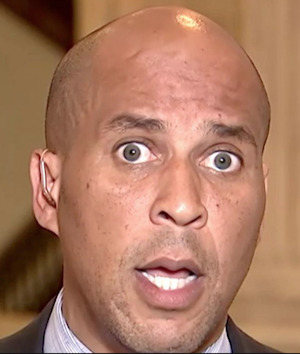
Laugh if you must, but Booker appeals strongly to the exact strain of idiocy that controls the strategy within the Democratic Party: He is a black male... like Obama! That means he will win, since Obama did. Yes, anyone who spends a few minutes studying Booker will realize he lacks Obama’s intelligence, wit, and oratorical ability. But that’s not how the Democratic establishment understands politics: they believe, genuinely, that the way to win is to raise the most money while being in possession of the correct identity markers. Should a candidate do this and lose, as Hillary did, it was the inevitable result of machinations outside of their control. Ergo, we must appoint the anointed one and see if he pleases the gods. Plus, if you mute the TV and squint, Booker totally looks like Obama!
Hillary

The main benefits of wokeness--why it has so many adherents, so far as I can tell--is that it allows certain people to skirt all responsibility for everything they say and do, even as it forces others to attempt to adhere to literally impossible programmatics of speech and comportment. And so Hillary’s recent nativist turn will be forgiven (it will most likely go unmentioned), while Bernie’s wardrobe and posture will be used as evidence of his sexism. She can continue making jokes about Colored People Time, while any of her competitors will be crucified for not using the exact right terms in describing whatever happen to be the Woke Cause of the Day. This insulation from criticism is Hillary’s biggest strength with the Democrat electorate, while her fiscal conservatism will continue to help her with donors. She will get beaten horribly in the general, but still stands a strong chance in the primary.
Joe Biden
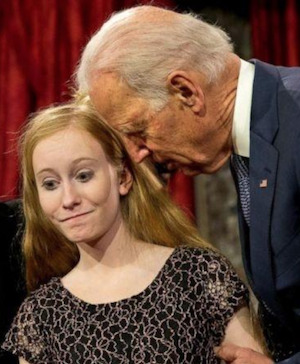
I have no idea how this man is leading in some polls other than name recognition. Which--don’t get me wrong, name recognition is huge, especially in early goings within a crowded primary field. But what does Biden bring to the table, policy-wise or personality-wise? I realize the people who bleat about how they don’t want any more OLD. WHITE. MALES. running for president are just trying to make their cruel centrist politics appear radical--but could they be shameless enough to actually throw their support to Biden? Biden, the dude who most certainly would have been MeToo’d were he still in a position of power? Biden, the pro-war economic conservative who repeatedly says that young people just need to stop whining? That’s the guy you’re gonna run against Trump? Probably. I would take a 50/50 bet on him winning the nomination.
Final odds:
Biden: 1:1
Hillary 1.5:1
Bernie 4:1
Booker 8:1
Beto 10:1
Harris 12:1
Field (including only aforementioned candidates): 30:1
1K notes
·
View notes
Text
Wednesday Roundup 28.6.2017
First off, I’m going to pump myself up some because I just read an incredible number of comics within one day or so in order to get this review out on time and for once I actually managed it so hoora for me. Second off, holy crap a lot of my comics came out this week and I was kinda slammed and didn’t really realize it until it was happening and suddenly it was a whole lot of “uh oh” but that’s just me, my ridiculousness, and talking about sheer volume.
The real question here is, how did everything shape up this week? And if everything was good what was the best? And at this point do you all even trust my judgment to say what best is anymore lol
Guess there’s one way to find out!
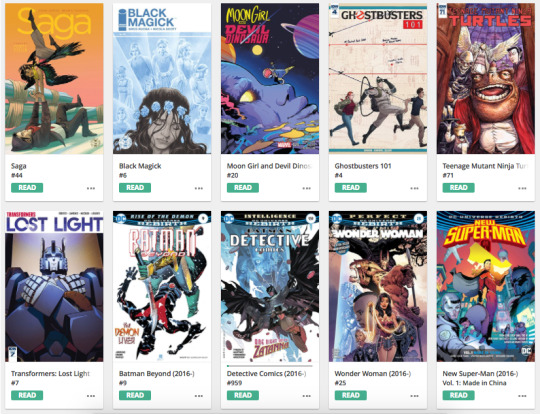
DC’s Batman Beyond, Image’s Black Magick, DC’s Detective Comics, IDW’s Ghostbusters 101, Marvel’s Moon Girl and Devil Dinosaur, DC’s New Super-Man, Kodansha’s Princess Jellyfish, Image’s Saga, IDW’s Teenage Mutant Ninja Turtles, IDW’s Transformers: Lost Light, DC’s Wonder Woman
DC’s Batman Beyond (2016-present) #9 Dan Jurgens, Bernard Chang, Marcelo Maiolo
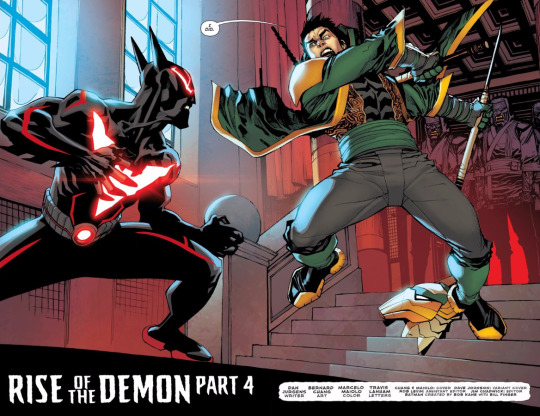
*long sobbing sighs are heard from the south of Alabama*
Okay, look. I have always prided myself on the fact that I’m not one of those comic fans that will buy just anything because my favorite characters showed up for three seconds one time in a splash page. I never consider myself someone who reads comics the way people read newspapers — just casually interested in the newest updates on this fictional world I follow at a distance. I come for the story and the characterizations and if they’re not there I won’t waste time and money. I mean there’s a lot of Dick Grayson comics I’ve flat-out ignored over the years and he’s one of my favorite fictional characters. Period!
But there’s… exceptions I can’t stop myself from.
Cassandra Cain, obviously. I make a point of owning everything with Cass in it. But the other is… I can’t avoid Batman Beyond. There is no part of me that can give up on Terry McGinnis, there’s a child in me who will always think of him first as Batman, who will always owe that cartoon for getting me even remotely interested in comics outside of Spider-Man and Teenage Mutant Ninja Turtles. I am a sucker for Terry McGinnis and I can’t help it.
which makes it suck that much more that he’s had basically no good comics featuring him since… 2008? 2009ish? And what’s decent ends up irritating me or making me have to turn against it because of the shit treatment other characters I like get.
Before it was Dick and Barbara I was up in arms for.
Now it’s Damian.
The more they try to retroactively shove the main DCU continuity into the DCAU Batman Beyond universe, the less sense it all makes and the more they have to warp characters we love. This Damian might as well have walked right off the pages of Batman and Son because he apparently has lacked all growth and humanity that Damian has achieved — has earned — in the last several years of comics, preboot and DEFINITELY post-New52 and Rebirth.
So that bears the question of what’s the point.
My “what ifs” from last issue of wondering if Damian is somehow controlled by his spinal implants again, that maybe Ra’s al Ghul took over his body the way DCAU Ra’s had Talia — those that I was fearful of now seem more respectful of his character than what seems to be the answer we have instead.
I have a feeling this conclusion is going to get me raging.
But because I am a sucker, because I am a ridiculous fangirl, I’m going to keep buying the things that hurt me. gdi Batman Beyond, can you be good again
Image’s Black Magick (2015-present) #6 Greg Rucka, Nicola Scott
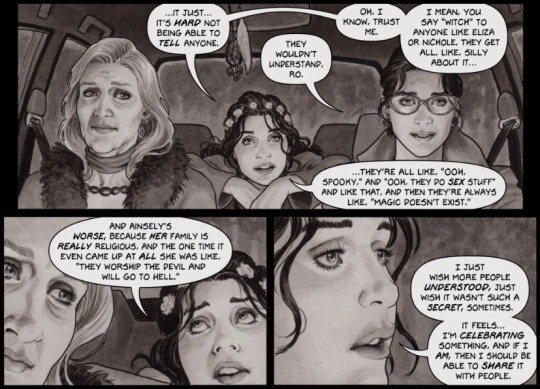
Okay but like…
Goddamn there’s no comic like a Greg Rucka comic oh my god.
Alright so I’ve always been a fan of Rucka’s creator owned works and I think they’re easily some of his best works which, as a fan, is really saying something on my part, but I have been utterly amazed by how good Black Magick has been and how Rucka just has this incredibly unique way of making every issue feel complete even while it’s part of a longer storyline. Every issue counts and I feel that in this issue almost as pure as I’ve ever felt it before.
Greg Rucka: he just gets comics.
In all seriousness, this interesting take on how magick works and how Rowan’s life specifically has been affected by her introduction to her long lineage’s powers — especially in light of what we know about present day Rowan Black and how she has not lived up to her potential as a witch just yet — comes together so well here. And I say that as someone who doesn’t really like flashbacks all that much in storytelling.
That being said, I’m so glad that this storyline is all in flashback and doesn’t have us whipping back and forth across timelines because I’ve gotten a lot of flashback fatigue from comics and movies lately. This is a nice, solid ground to stand on if we’re going into backstory territory.
DC’s Detective Comics (2016-present) #959 James Tynion IV, Alvaro Martinez, Raul Fernandez, Brad Anderson
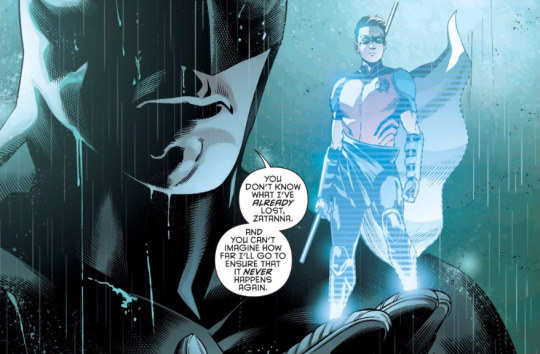
Alright, so I’m beginning to question about how the continuity of the various Bat titles are lining up anymore because, as we just went over a week? Two weeks ago? Bruce had just proposed to Selina. But now we’re getting some heavy flirtations with Zatanna here. Now, I’m all for threesomes and I actually multiship Bruce quite a bit and that includes shipping him with both Selina and with Zatanna, but this is kinda… stepping on the toes of whatever King’s doing. Which fine whatever. I’ll be honest, I’ve had a soft spot for longtime friendship and childhood crosshairs between Bruce and Zatanna thanks to how much I still just adore Paul Dini’s run on Detective Comics (1938-2011). So this pleases me almost despite myself.
That being said, there’s still a lot of unevenness in this story at the moment. Even with the cast diminishing through deaths and quitting and whatever, we have a lot of characters factoring in and out of the storylines from one to the next. It feels like we very barely have time to establish what everyone’s relationships are before we start hinting at even more shakeups. Are Jean Paul and Luke’s friendship going to be busted up after only a few issues of contact between them? Is Clayface considering taking up the doctor’s idea of a cure so soon after I still haven’t figured out why he’s even here? Is Tim’s not-death ever going to be brought up again before Bruce does something truly stupid?
And then there’s just that… looming threat of the summer event I just know is going to come up at some point.
There’s a lot of good in this issue, and I don’t want to knock it, it’s actually one of the more decent mid-story issues that Tynion’s produced so far. And I’ve been harping on him for that from the beginning so that’s saying something from me. And I thought the art this issue was actually very consistent and well done overall, even if I have to wonder how many times has everyone in the Batfamily stood in a perfect pose with a Batfan on them for the computer to scan and give a perfectly COOL holographic image of themselves. But that’s me being silly and questioning superhero world logic. A truly terrible road to go down.
A very interesting issue and I’m curious to see how the storyline with Bruce ties into the storyline about Jean Paul’s struggles with his religion and how his past has warped it. Not that… as a Catholic those… struggles ring true… or anything.
Anyway, seal of approval and waiting for the story to continue on!
DC’s Ghostbusters 101 (2017-present) #4 Erik Burnham, Dan Schoening, Luis Antonio Delgado
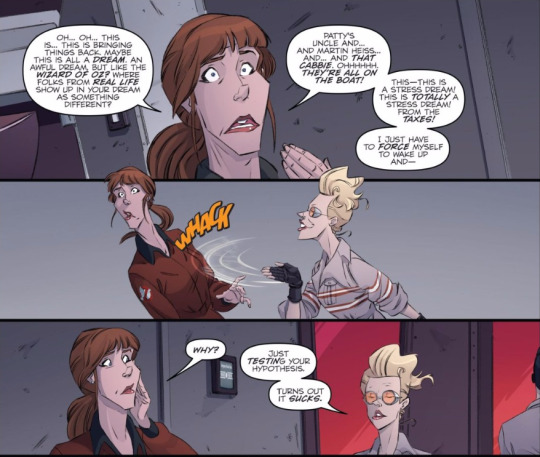
Alright, so IDW is just kicking ass with their properties this week and I honestly think that there’s nothing better to combat the absolute bile and grossness that was the internet fanboys of the Ghostbusters circles more than seeing just how amazing and interesting Burnham and Schoening have made this team up with all generations of Ghostbusters at once.
Erin and Holtzy definitely take the cake this issue and there’s a lot of fun, especially with how the Ghostbusters of different universes compare equipment, ghosts, and methodologies as they address one thing about the 2016 movie that actually did bother me quite a bit which was that the ladies just kept… dispersing ghosts and not capturing them where all incarnations before had made a point of the “conservation of ghost matter” or whatever before — establishing that ghosts would just reappear en masse if not absorbed and captured. The explanation was actually rather witty and made perfect sense with the narrative of the 2016 movie, actually.
One of my favorite aspects, though, has to be how many in-jokes they manage. Erin’s neuroses and figuring out how the various cameos in their universe fits into the original’s universe, the joke about Caddy Shack, and just so much more.
It was a really fun issue and I hope people are picking this up and giving it a chance, especially if you enjoyed the 2016 movie, and especially especially if you didn’t but are willing to see the potential that team had all along.
Marvel’s Moon Girls and Devil Dinosaurs (2015-present) #20 Brandon Montclare, Natacha Bustos, Tamra Bonvillian
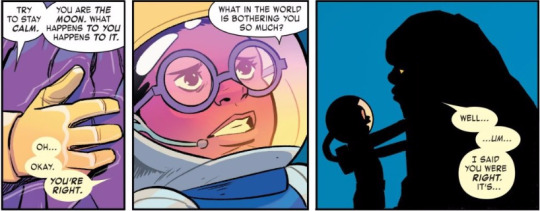
It’s amazing that Marvel is ruining properties by turning them into evil Nazi stand-ins and warping everything good to come out of Marvel’s initial inception while, in the meantime, they have such good and pure creators making a story like Moon Girl and Devil Dinosaur who give us fantastic all-age stories with beautiful art, a lovable and flawed main heroine, and an honestly rather mature and disquieting storyline.
A kids comic where she learns she can’t save everyone. And it’s still poignant and beautiful. It’s still powerful and speaks on a child’s level.
But it sets up for the first time that Lunella, wonderful and smart and brave as she might be, is imperfect. She can’t save the world (or, in this case, the moon) by herself and she can’t always appreciate people’s feelings and their deserving of her empathy until she works on it. She’s been trying so hard to prove herself and show how good she is at everything, she’s allowed herself to stop thinking of everyone as her equal.
So much so that her replacement with an unfeeling robot only gets mild suspicions from her friends at school.
who hilariously know about Lunella’s super identity and her powers because fourth graders can’t keep secrets and i love that.
It’s just such a good story and it’s remarkable that we live in a time where Lunella Lafayette gets to be kids’ introduction to comic books.
DC’s New Super-Man (2016-present) Vol. 1: Made in China Gene Luen Yang, Viktor Bogdanovic, Richard Friend
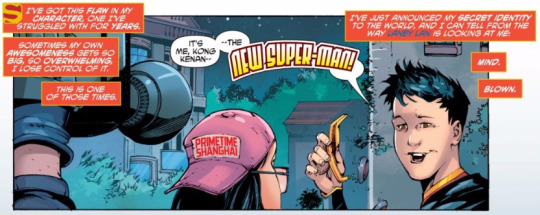
Kong Kenan is the New Super-Man of China and he could not be more of a change from the status quo of the American superhero archetype of Superman if he tried! Now, that’s not completely fair, obviously there’s quite a bit of convention bending to the genre in this story right from the start, but honestly it felt from the start like a very honest look at just what superheroes would mean for the world outside of America once the Justice League appeared and changed everything. And why wouldn’t other countries be scrambling to make sure that they could compete with not just the rising threat of super villains, but with the potential firepower that would be superheroes representing and being beholden to other countries.
DC and Marvel both have made varying attempts to answer those questions themselves over the years, and Kenan doesn’t serve as the first Chinese superhero in the DCU, but this is definitely the first time I as a reader felt like I was reading an experience and perspective outside of my own. Usually there’s a lens or veneer to these attempts to expand superheroes outside of the US that’s pretty transparent — they’re either very rarely seen or explored and so lend themselves to vague understandings of other cultures (such as The Great Ten in the preboot) or they’re Americanized in some way, usually by having them join a team of characters that are from the American perspective (Bushido from Super Friends) or having them come to move to America and have the whole experience of being an immigrant or student work visa (Ryan Choi’s The Atom).
For me, it felt like New Super-Man is taking the very notable effort of examining a purely Chinese character and setting from that perspective and building off of the uniqueness inherently built in that, but also showing how Chinese people’s views of the West and of American superheroes would reflect in their own attempts to make a superhero for themselves. And why Kenan, while initially seeming to be unfit to be a Super-Man given a history of being rather haphazard and a bully, could actually bridge that gap and provide a really interesting story of learning what being a superhero means for a culture so different from America’s own.
At least, that’s my take on it. While I’m happy to boast about the fact that I’m from a family of immigrants in America myself, I’m still a product of the West and Europe, and I’m reading the New Super-Man with that perspective, and assumedly a lot of other readers are, too. So it’s hard for me to tell how accurate my takeaway is here.
I’m only fleetingly familiar with previous works by Gene Luen Yang, but I have to give him major props here. I’m more familiar with his work with the Avatar: The Last Airbender comics than I am with his more acclaimed work (American Born Chinese and Boxers & Saints) which I desperately need to fix, but I have no doubt in his abilities to portray characters which are good but fundamentally flawed. That was a trademark of his works that I have read, and he really brings that to life in New Super-Man with Kenan. He is a very flawed, very human character that relates to readers based on personality before the differences between America and China can even be brought up in the narrative. And that’s what really made this a fantastic read by the end.
I’m very interested to see where this story continues with Vol. 2 and hope that the reader base for this story grows along with Kenan’s character.
After all, right now the world could use a Flawed But Good Super-Man almost as much as it could use a Chinese Super-Man.
Kodansha’s Princess Jellyfish (2008-present) Chapter 82 Akiko Higashimura
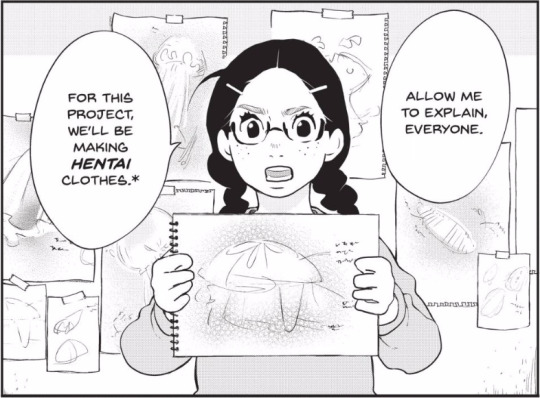
I believe that it’s pretty obvious, the further we go along with my comics reading and these reviews, that I had a pretty large variety of comic tastes. And really that just has to be indicative of my feelings about narratives in general. There’s a lot of things I appreciate about media’s ability to tell stories, and good stories and good characters, for me, almost always trump genres at the end of the day.
And I have loved Princess Jellyfish since the 12 episode anime adaptation of the first arc aired back when I was in college and @red-dye-number-five and I squealingly watched it as it came out.
The series is very soothing for me to read and this chapter was no different in that way. I have no interest in fashion, but the story of this found-family of adult women blundering their way through the world of fashion to save their community and home speaks to me. I really hate love triangles, but the complexities of the relationships between Tuskimi, Shu, and Kuronosuke has made for some of the most interesting and fascinating dynamics I’ve seen in a romance drama. And while I don’t usually go for coming-out stories anymore, the difficulties and self doubt and guilt we see with Kuronosuke over and over again as he tries to find his personal comfort with his gender and sexuality is honestly heart wrenching and I’m fully invested with.
I enjoy this series so much and as usual we have another chapter that fully delivers on its continued promises. This isn’t a perfect series, but for me it is a bit of chicken soup in the middle of the difficulties of life.
Image’s Saga (2011-present) #44 Brian K. Vaughan, Fiona Staples
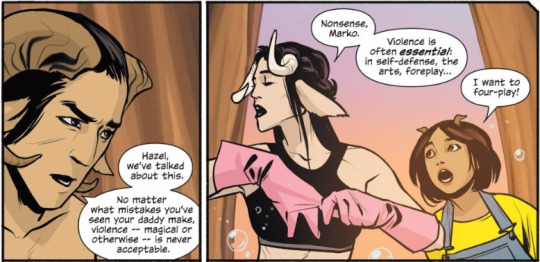
I think in twenty, thirty years, we’re going to look back and find that the generation of comics that have come about in the 2010s have changed the medium to a diverse haven of storytelling that comics hasn’t honestly enjoyed since the Comics Code and so on. And thank god for it because we get to read Saga as it’s being published and experience it as the true game changer that it is.
We are experiencing a storyline, from the perspective of a woman, who has to undergo a medical abortion, is being sent on a trial of Jobe for it because of the regressive tendencies and behaviors of her own people, and getting to see how much that burden is adding onto her own torment. We rarely get stories about abortion let alone ones where it’s from the woman’s prospective, is pro-abortion but also honest about its difficulties, and clearly shows avid anti-abortion rhetoric and laws as being crippling and more hurtful to those going through the ordeal than helpful.
It is… unfortunately very relevant to our times.
As is all of Saga’s storytelling. People see the nudity and violence and sex and gore every issue and what I love about Saga is that those things are so average, so unremarkable, that the actual mature content like addiction, prejudice, racism, homophobia, transphobia, infidelity, parenthood, and everything else in between is given the gravitas and exceptionalism it deserves outside of the seedy details that too often help the important points get lost in other lotted “mature” content.
In other words, there’s so much peeing on beds that we don’t lose track of the intrigue of money laundering and collusion as the real stories.
IDW’s Teenage Mutant Ninja Turtles (2011-present) #71 Kevin Eastman, Tom Waltz, Dave Wachter, Ronda Pattison
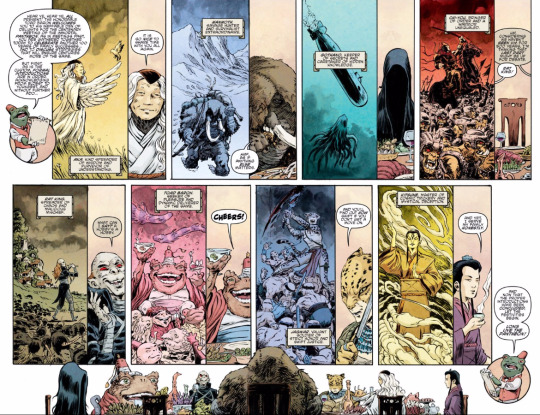
There’s not a whole lot to say about Teenage Mutant Ninja Turtles usually because, as with the best comics with the most consistent quality, they just are great and just should be read and there’s hardly much else I can say about why if you haven’t been sold on it already. It’s like me trying to explain to people why they should read Usagi Yojimbo. If you’re not reading it already I don’t know what I can say to make it understandable how much you need to read it.
That being said, this is a slow issue compared to TMNT’s usual action packed fare. And I think that’s for good reason. We need buffer time between stories, this is part one of a two-parter which provides just that, and it spends its entire time building on the lore and mythology of the world of TMNT as it has been realized by IDW. And it’s fascinating and complex and meaningful.
And of course as a mythology junkie I adored every second of it — learning about the Pantheon and the gods of this universe was fascinating and knowing how various previous canons of TMNT are being incorporated to provide it is amazing (I especially love Jagwar’s new self I’m in love). It was fascinating, as has been the amount of love Eastman and Waltz have shown TMNT overall.
It’s a good comic, a slow comic, but good. And I really enjoyed the read. Definitely something different added to today’s pretty sizable pot.
IDW’s Transformers: Lost Light (2016-present) #7 James Roberts, John Wycough, Jack Lawrence, Joana Lafuente
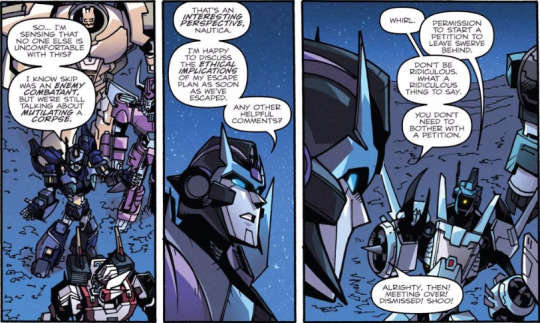
You know that vin diagram that’s things that are okay and then this over waaaaayyyyyy on the outside? Okay. Good. Because that’s what this issue is for me. Holy shit. My emotions have been played like a fiddle and I am sick and engrossed and devastated and uplifted and there are things that I cannot say or do or what. WHAT.
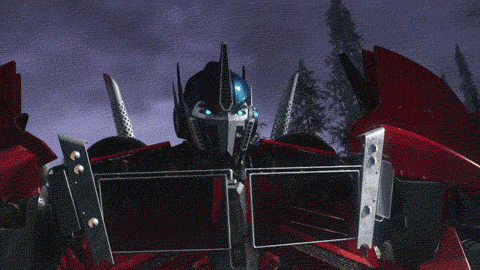
Okay so I wasn’t entirely sold on this recent storyline opening up the Lost Light, if I’m completely honest. I share a lot of the concerns I’ve seen other fans show with regards to just how much retconning of a pretty unforgivable past Megatron has been shown to have in canon prior to 2011 and how he’s being handled now. And this storyline in a lot of ways was both a redirection to what Transformers should always be about — the fighting of fascism — but also felt like we were going a step too far into the department of “see! Megatron wasn’t the REAL evil fascist, here’s what cartoonishly evil fascists REALLY look like” so as much as I enjoyed this story and as much as I really admire James Roberts’ writing in general, I was on the fence about what to feel about everything that had gone down.
Which made the fact that he took the time to dedicate an entire issue to the aftermath, gauging all the different reactions to the plots that had emerged, giving me a new lesbian couple and bypassing the gross route of having one remember and the other not, and then hammering in the Cygate romance to a conclusion I ABSOLUTELY DID NOT WANT OR NEED BUT AM TOTALLY INVESTED IN…. it’s not just cathartic. For the first time I genuinely feel like the sharpness, wit, depth of character, and real solid execution is back to the standards of what I still consider to be my favorite work of JRo’s which was MTMTE Season 1.
This was just… so much to take in, and so fast, and I swear not an inch of panel was wasted. I’m hoping that this means the pace is picked back up, the course is put back on track, and we return to what was making the characters so fantastic and loving and… oh yeah
TOTAL FRIDGE HORROR FOR THOSE OF US WITH CLAUSTROPHOBIA

I really liked this issue. It’s definitely my favorite of Lost Light so far and has me looking super forward to what happens next. Which is something I desperately needed since I learned Till All Are One, which has honestly been my favorite TF comic for the past year, is ending soon.
DC’s Wonder Woman (2016-present) #25 Greg Rucka, Bilquis Evely, Liam Sharp, Romulo Fajardo Jr.

I have been curious since the announcement of Rucka’s departure from the title just how he was going to pull together his past and present storylines, how things were going to end up. And I have been met with the answers which are large, satisfying, and a bit saddening in knowing that we’re quickly approaching the end.
The idea that, without the lasso, something is simply missing from Diana and her life feels like a great commentary on Wonder Woman herself, and what not only embracing her history and iconography means for the character but what it means for her personality itself. Without the lasso, without her faith, without the support of the Amazons at her back, Diana is shorter with her temper, more quick to anger, more brutal. And it’s not her, it the her that people have tried for decades to turn her into to suit their interpretation of what a Wonder Woman should be. And it’s concerning to the people who love her — here exemplified in Steve, Etta, Bruce, and Clark — and unhelpful to the enemies who require her sense of compassion and understanding, which is what nearly all of Diana’s enemies have been constructed to show — here Cheetah and Veronica Cale.
She’s simply not Wonder Woman without those things, and it’s such a relief to have a modern writer with the caliber of Greg Rucka portraying that in a deft and almost poetic way as it has been in this title and especially in this wrap up issue. It makes me happy to have the character of Wonder Woman brought back to herself on the terms of someone who has as much love and respect for her as Rucka does.
It was a good issue, and while I will be the first to say that this run hasn’t been perfect and that Rucka’s shown some genuine problems in his writing through it, I am sad to see it all coming toward its end.
So if I had to sum up this week’s comics as a whole I would just say that I was smacked with a whole lot of emotions all across the spectrum. But as I consider it tonight and really think about what has stuck with me the most in the aftermath of getting through them all, I really can’t understate how much Transformers: Lost Light threw me through about twenty different loops -- I mean the subplot of Cyclonus and Tailgate’s romance alone would earn that spot of just WOW but literally every character, every development, every scene blew me away this week and it really uplifted me to enjoy the read as much as I did again.
But that’s just my opinion. What are your thoughts? Agree? Disagree? Think I missed something this week I should’ve picked up? I’d love to hear from you on it.
Until then, here’s to another Wednesday full of comics!
#Rena Roundups#SPOILERS#Wednesday Spoilers#Princess Jellyfish#New Superman (2016 )#Wonder Woman (2016 )#Detective Comics (2016 )#Batman Beyond (2016 )#Transformers: Lost Light#Ghostbusters 101#Moon Girl and Devil Dinosaur (2015 )#Black Magick#Saga
7 notes
·
View notes
Text
Best Tv Series Of All Time
'South Park' 1997-Present
Matt Stone and Trey Parker touched America somewhere specific and deep, and also you must respect their authori-teh. Year after yr, this cartoon began, Matt Stone informed Rolling Stone, "We would see achievement as lastly getting to the point where we get canceled because no one gets it." So here's to not exactly twenty years of failure – and hopefully 20 more.
youtube
'Monty Python's Flying Circus' 1969 74
And now for some thing completely various. The best comedy cock tail – five British intellectuals along with a token American clod, Terry Gilliam, running amok about the BBC. Monty Python were the Beatles of comedy, each one an indispensable aspect in the chemistry, from John Cleese rage to Eric Idle -stick wordplay. The Pythons were godfathers to all ambitious jokers who adopted – Lorne Michaels and Chevy Chase satisfied in line for an Ultimate Goal screening. But these 45 episodes stay the comedic equivalent of Mount Everest: the mountain with all the biggest tits on earth, forbidding, aloof, terrifying.
youtube
'Game of Thrones' 2011-Present
The night is dark and full of terrors, particularly. With its premise of "The Sopranos in middle earth," it is the HBO fantasy sequence that broke through style boundaries to stake its claim as one of the most compellingly realistic dramas on the air, going beyond George R.R. Martin's publications. It may grab attention with the nudity, the dragons and severed heads, but in your mind it's a thriller. As Martin told Rolling Stone, "History is written in blood, a gold mine – the kings, the princes, the generals along with the whores, and all the betrayals and wars and confidences. It's better than 90 percent of exactly what the fantasists do make up."
youtube
'Cheers' 1982 93
You need a place where everybody knows your title – even supposing it's just a dive-bar in Boston total of regulars with no place else to go. Cheers started with an emphasis on the mis-matched passionate banter between Ted Danson's washed-up Red-Sox pitcher Sam and Shelley Long's up tight bookworm Diane. ("Over my dead body!" "Hey, do not b-ring last night into this.") But it regularly renewed it self by bringing in new blood like Kelsey Grammer, Kirstie Alley and Woody Harrelson. Cheers was like that bar, to the point where you can tune in to see which regulars would hang tonight.
youtube
'The Daily Show' 1996-Present
The fake news show that became more credible in relation to the news. Comedy Central began The Daily Present in 1996, when Jon Stewart took over in 1999, but it hit its stride. The Everyday Present got more abrasive as the the headlines got worse. Stewart had the rage of a man who'd signed on in the end of the Bill Clinton years, only to finish up with an America significantly scarier and uglier for, and also the anger showed. "It really is a comic box lined with sadness," he advised Rolling Stone in 2006. While the franchise struggles on without him, Everyday alumni John Oliver and Samantha Bee keep that hardhitting spirit on their own shows.
youtube
'Twin Peaks' 199091, 2017
"These women are authentically dreamy," Twin Peaks auteur David Lynch told Rolling Stone in 1990. "They are all just chef chicks. And they're just jam-packed with strategies." The little town of Twin Peaks is complete of the women as well as their deadly secrets, from senior high school homecoming queen Laura Palmer that is murdered to alive-and- how seductress Audrey Horne. Several years after Blue Velvet, Lynch's surreal Pacific Northwest secret followed Kyle MacLachlan as FBI agent Dale Cooper, on a search for damn-good espresso along with the the answer.
youtube
'Deadwood' 2004-06
Al Swearengen's moral philosophy: "You can't cut the throat of every cock-sucker whose character it would boost." Spoken like a Founding Father that is true. He is the villain of David Milch's epic Western set in the mud and slime of an 1870s South Dakota gold-mining camp. At the center of it all (i.e., the saloon), Ian McShane's Al glowers, pours drinks, counts money and slices jugulars, in a frontier hellhole total of prospectors, whores, drunks and lost freaks looking for one last deadly fight to get in to (and often finding it at Al's spot). It was like McCabe & Mrs. Miller with mo Re depressing intercourse scenes. The first two seasons are strong gold, the third, flimsier, but Deadwood is about how communities get constructed – and every one of the dirty function that involves.
youtube
'The West Wing' 1999-2006
Aaron Sorkin gave America the the first choice we didn't really deserve in the benevolent President Jed Bartlet of Martin Sheen, a high-toned Catholic professor from New Hampshire. Premiering in late 1999, The West Wing played the same as a Bubba-period fantasy of the way the political potential would appear (like in case the Democrats had a little more bravery, or in the event the Republicans had a theory or two) that soon ended up being utterly out of step with the Bush-Cheney years. But Sorkin's trademark rapid-fire dialogue as well as the Bartlet administration's idealism created this a parallel-universe that was a welcome.
youtube
'Louie' 2010-Present
Louis C.K.'s stubbornly auteurist FX sit-com doesn't look or sense like any such thing else on Television – he writes, directs and stars as himself, a single-dad stand up comic in New York. If Louie wants to display himself in the car air-drumming to "Who Are You?" and mortifying his daughters, he goes for this. If he desires to abandon the half hour comedy format completely for an extended indie-movie vibe with Charles Grodin and Ellen Burstyn, he does that too. Louis C.K. May vanish in to his own head for whole seasons, however totally original emotional peaks are also hit by him just like the one when he inadvertently makes a buddy that is male and travels to Miami. (No, it does not last.)
youtube
Third Watch Season 6
'Star Trek' 196669
The Star-Ship Enterprise took off using a five-year mission: "To discover odd new worlds, to seek out new life and new civilizations," and it succeeded in making the most beloved of sci-fi franchises, maybe not just inspiring countless spin offs but also codifying fan fiction as an art form. Gene Roddenberry's original collection remains the the inspiration, with William Shatner's awesomely pulpy Capt. Kirk, Leonard Nimoy's logical Mr. Spock, Bones, Sulu, Uhura and Scotty. They speak to strange and inexplicable lifeforms – Romulans, Gorns, Joan Collins. During its three years, Star Trek endured low ratings until NBC pulled the plug, but thanks to the most doggedly faithful of TV cults (remember when "Trekkie" was an insult?), Roddenberry's vision lives long and prospers to the day.
youtube
1 note
·
View note
Text
Book Review: Hunter Thompson, 'Hell's Angels'
Leo Litwack, New York Times, 29 January 1967
In 1965 the Attorney General of the State of California distributed a report on the Hell's Angels Motorcycle Club to law enforcement agencies throughout the state, urging that all measures be taken to contain the menace of this elite outlaw organization.
According to the Lynch report, the 450 members of the club had a record of 874 felony arrests, 300 felony convictions, more than 1,000 misdemeanor convictions. The report held that there would have been an even more extensive record, but for the Angels' practice of intimidating witnesses.
The criminal actions listed by the Lynch report ranged from the terrorization of rural communities to the theft of motorcycle parts. Included were detailed charges of attempted murder, assault and battery, malicious destruction of property, narcotics violations and sexual aberrations. Investigating officers further reported that "both club members and female associates seem badly in need of a bath."
It was a picture of alarming menace. Depraved hoodlums—unmanageable, incorrigible, vindictive and organized—roamed the California highways in stripped down Harley-Davidson motorcycles. They were dressed like pirates, with full beards, a ring in one ear, shoulder-length hair, an embroidered winged skull on the backs of their sleeveless denim jackets, Iron Crosses on their chests, swastikas on their helmets. These weren't the teen-agers of the usual urban gang, but adults, ranging in age from the early 20's to the mid-40's. They could strike anywhere in the state, and they didn't fear the police. The underground in which they were lords seemed dark, rancid, impenetrable.
Hunter Thompson entered this terra incognita to become its cartographer. For almost a year, he accompanied the Hell's Angels on their rallies. He drank at their bars, exchanged home visits, recorded their brutalities, viewed their sexual caprices, became converted to their motorcycle mystique, and was so intrigued, as he puts it, that "I was no longer sure whether I was doing research on the Hell's Angels or being slowly absorbed by them." At the conclusion of his year's tenure the ambiguity of his position was ended when a group of Angels knocked him to the ground and stomped him.
Without denying that the Angels are violent, unpredictable and dangerous, Thompson regards the Lynch report as vastly exaggerating their menace and misrepresenting their life in crime. "There was a certain pleasure," he writes, "in sharing the Angels' amusement at the stir they created."
According to Thompson, the membership is in the neighborhood of 100, not 450 as the report claimed. The failure to get convictions had less to do with the intimidation of witnesses than with the baselessness of the complaints. Police harassment was responsible for the large number of misdemeanor convictions. Thompson, noting the relatively insignificant part the Angels play in California crime statistics, is amused at the disproportionate publicity they have secured. He argues that publicity saved the club from extinction. Prior to the Lynch report, club fortunes were on the wane. The Lynch report called the Angels to the attention of national media and with the "publicity breakthrough" they again flourished. Thompson, in a tone of exuberant irony reminiscent of Mencken, comments, "In a nation of frightened dullards there is a shortage of outlaws."
The underworld Thompson reveals to us is a more familiar terrain than the shadowy nightmare world of the Lynch report. He doesn't find an effective criminal conspiracy, nor does he see an organization ground in Nazi ideology. He draws a picture of desperate men, without status and-- despite their motorcycles--without mobility. He traces their origins to the Okies and Arkies and hillbillies who migrated to California during the Depression. He finds the literary prototype of their ancestor in the protagonist of Nelson Algren's "A Walk on the Wild Side," Dove Linkhorn. Most Angels are uneducated. Only one Angel in 10 has steady work; "Motorcycle outlaws are not much in demand on the labor market." The world demands skills they have no chance of acquiring; "They are out of the ball game and they know it." They have no future; "In a world increasingly geared to specialists, technicians, and fantastically complicated machinery, the Hell's Angels are obvious losers, and it bugs them."
They survive in various ways. According to Thompson, a few have steady work, some pander, some steal, some live off their ladies. Some are married and faithful to their wives. Others have a predilection for gang love. What they share is a guiding concern to be "righteous Angels" and a love for motorcycles. An Angel is quoted as saying, "We don't lie to each other. Of course that don't go for outsiders because we have to fight fire with fire."
Thompson describes the attitude of a Hell's Angel to outsiders as follows: "To him they are all the same--the running dogs of whatever fiendish conspiracy has plagued him all these years. He knows that somewhere behind the moat, the Main Cop has scrawled his name on a blackboard in the Big Briefing Room with a notation beside it: 'Get this boy, give him no peace, he's incorrigible, like an egg-sucking dog.'"
Mounted on his bike, he assumes a dignity he often lacks on foot. The high-speed trip described by Thompson is akin to the psychedelic trip made on LSD. The Angel has small chance of assuming the role of hero save in a fantasy trip. "Most Angels. . . are well enough grounded in the eternal verities to know that very few of the toads in this world are Charming Princes in disguise. The others are simply toads, and no matter how many magic maidens they kiss or rape, they are going to stay that way."
Vindictive at being toads, they invert the ethic of Prince Charming. The initiation ceremony of an Angel centers on the defiling of his new uniform and emblem. "A bucket of dung and urine will be collected during the meeting, then poured on the newcomer's head in a solemn baptismal." They never wash their soiled colors. They mock the courtly love of Prince Charming with gang love. Instead of the gentlemanly duel they subscribe to the principle of All on One. They don't seek justice in dispensing punishment. Rather, the response is always one of total retaliation. "If a man gets wise, mash his face. If a woman snubs you, rape her. This is the thinking, if not the reality, behind the whole Angel's act."
The Angel rejects precautions, whether riding a motorcycle or entering a brawl. "They inhabit a world in which violence is as common as spilled beer." The Angel has been injured so often that he is indifferent to pain. "This casual acceptance of bloodletting is a key to the terror they inspire in the squares. . . . It is a simple matter of having been hit or stomped often enough to forget the ugly panic that nice people associate with a serious fight." The "reality behind the Angel's whole act" is that most of the damage is inflicted on themselves. An average of four die violently each year.
The easy acceptance of violence lends to Thompson's account a cartoon quality. We observe Angels brutalizing themselves and others and somehow we expect them to recover as quickly as the cartoon cat and mouse. It's not that Thompson doesn't give us a vivid picture of brawls and orgies. His language is brilliant, his eye is remarkable, and his point of view is reminiscent of Huck Finn's. He'll look at anything; he won't compromise his integrity. Somehow his exuberance and innocence are unaffected by what he sees.
Dirty Ed is laid flat by a two-foot lead pipe, but he gets up and drives away on his motorcycle. Terry the Tramp is stomped by the Diablos, a rival gang, but he still manages to make the Labor Day run. We see a mass assault on a compliant lady during a party; the dancing continues. A 7- foot Negro invades the Angel clubroom. He is overwhelmed, cast down, kicked in the face and belly, dumped in the parking lot. He gets up and walks to the ambulance. During Thompson's last interview with a group of Angels, he is suddenly struck from behind, then from all sides. He is knocked down and stomped. He is almost done in by a "vicious swine trying to get at me with the stone held in a two-handed Godzilla grip." He gets to a hospital unaided.
Because the Hell's Angels have lacked a focus for their hostility, their violence has been undirected. However, those who observe the trappings--the swastikas and Iron Crosses--have wondered if there might not be in them the raw material out of which Brown Shirts are made. This suspicion seemed confirmed when, in the fall of 1965, a group of Hell's Angels attacked an anti-war rally at the Oakland-Berkeley boundary, an assault which put them into direct conflict with the radical left in neighboring Berkeley.
"The attack was an awful shock to those who had seen the Hell's Angels as pioneers of the human spirit, but to anyone who knew them it was entirely logical. The Angels' collective viewpoint has always been fascistic. They insist and seem to believe that their swastika fetish is no more than an anti-social joke, a guaranteed gimmick to bug the squares, the taxpayers--all those they spitefully refer to as 'citizens.' . . . If they wanted to be artful about bugging the squares they would drop the swastika and decorate their bikes with the hammer and sickle. That would really raise hell on the freeways. . . hundreds of Communist thugs roaming the countryside on big motorcycles, looking for trouble."
However, the threat to disrupt all future anti-war demonstrations didn't materialize. A visit from poet Allen Ginsberg and novelist Ken Kesey served to pacify the Angels and there has been no recent sign of political direction.
Hunter Thompson has presented us with a close view of a world most of us would never dare encounter, yet one with which we should be familiar. He has brought on stage men who have lost all options and are not reconciled to the loss. They have great resources for violence which doesn't as yet have any effective focus. Thompson suggests that these few Angels are but the vanguard of a growing army of disappropriated, disaffiliated and desperate men. There's always the risk that somehow they may force the wrong options into being.
#hunter s thompson#hell's angels#literature#book review#hunter thompson#gonzo#new journalism#motorcycle#gang#bikers#counterculture#1967#1960s#sixties#60s
1 note
·
View note
Text
Exquisite Animations: Exploring the Exquisite Corpse in Animation
In this post, I’ll be taking a look at a few examples of an Exquisite Corpse in animation - and explore how the animators smoothly transition between each sequence.
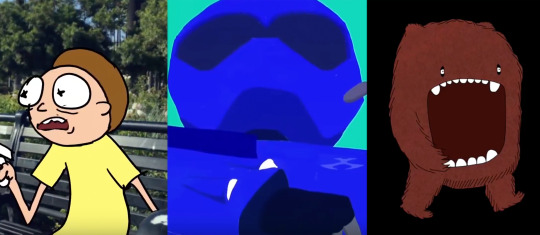
The first example I’ll be looking at is the aptly-named ‘Exquisite Corpse’ from Toonami. It’s an animated collaboration project that celebrates the 20 years of the beloved programming block, which brought western audiences an awareness of a medium somewhat over looked, Japanese animation called anime. The project is just under three minutes long, a showcase of talented animators and a range of visual styles and techniques.
The sequence follows programming host TOM as he’s thrown into a lucid space adventure. The plot is rather loose, something arising from the various artists and aesthetics blending into one piece - there’s not an in-depth narrative because it’s a celebration of the block and animation as a craft. It’s about visual interest, flair and most importantly - movement.
It’s a bright, vivid electric animation showcase with dynamic motion, an energetic and exciting tempo and an unrelenting electric sonic score that underpins the entire project. There’s a variety in animation styles and aesthetic, with TOM being stretched from a 2D illustration to a claymation sculpture.
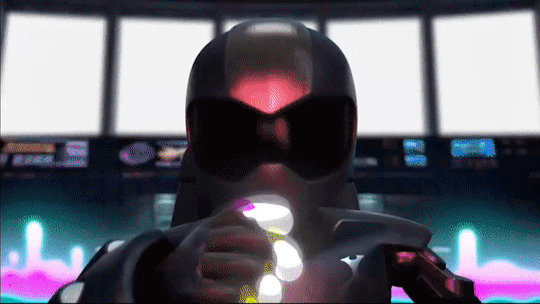
The motion is fluid, and inherently exciting due to the relentless pace and beat of the piece. There’s an electricity to the animation that’s a result of the continuously metamorphosing main character, and fluid backdrops. However, it is, at times, visually tiring and dizzying - Toonami’s Exquisite Corpse could be considered a visual overload - something which could actually put a few audience members off the project as a whole. There’s frequent flashes of light which serve as quick transitions into different styles, and an acid-inspired, ever-changing colour scheme that could dizzy some viewers.
I was suprised at how experimental some segments were, having textured lines and colours morph into abstract shapes and forms, before leaping into hand-rendered sketches of the robotic character. There’s a vast amount of visual styles and approaches that embody the ideas of an exquisite corpse nicely, and for the most part, the transitions are smooth and visually quite pleasing.
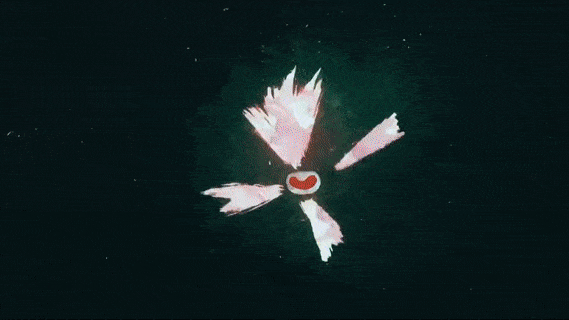
As I begin to move forward in my project, and experiment with different mediums and animation techniques, I want to be exploring how to blend each sequence together - into my own animated exquisite corpse. My analysis on each example here will be brief, as the main purpose of this research is to explore ways in which animators transition from each sequence - which ones are successful and how I can learn from these approaches.
Watching the animation on a much slower speed, I found that most of the transitions were achieved through flashes of light and dark, and having a subject grow so large in the frame that it’s a solid block of colour which then fades into the next sequence. The most important element of this example is speed - Toonami have created the illusion of fluid transition through not spending time or putting focus on it. I think this is the key to the success of the piece, that the transitions are almost an afterthought. Flashes to black, having the camera zoom or blur allows the next sequence to either flash onscreen or quickly fade in.
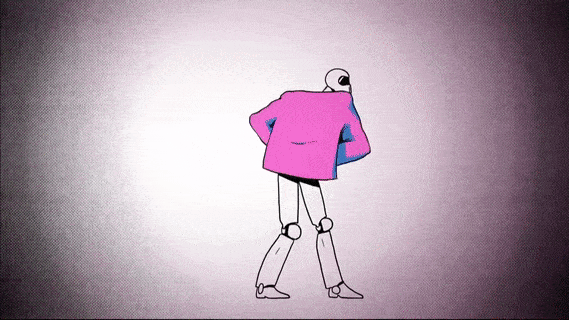
An idea that I want to explore a bit more in my research is my own criticism - I’m critical of my own work, and thus I should be discussing the successes and failures of the examples I’m looking at.
With Toonami’s example, there’s a lack of 3D integration that I think would add a richness to the animation. It’s a block celebrating anime - a primarily 2D art form - but I feel like experimenting with even more techniques would allow the piece to be more visually exciting and interesting to general audiences, not just fans of anime. There’s a limitation with just 2D animation, and we get glimpses of this with claymation shots - but these are ultimately submerged and overlooked by an extensive amount of digitally drawn 2D animated sequences.
It’s a visually exciting sequence with some rather simple approaches to transitions - but that simplicity allows the actual animations to shine instead of flashy transformations or transitional movements. It’s quick, minimal and simple - an approach I want to be exploring in my own responses.
Acting as a trailer for the hit animated series Rick and Morty, my next example, Exquisite Corpse is a fantastic collaboration of animation artists from around the world. On his blog, Creative Director Matt Taylor described the project as an ‘amazing puzzle to solve … a beautiful work of visual art.’
Honestly, I couldn’t agree more. It’s a brilliant piece of animation with an unbridled creativity and artists that clearly love their craft. The film starts with character Morty spilling one of Rick’s latest experiments, which begins our trip through the Rick and Morty multiverse, fit with dozens of creative animated sequences and soundtracked by an instrumental version of hip hop duo Run The Jewel’s ‘Thursday in the Danger Room’.
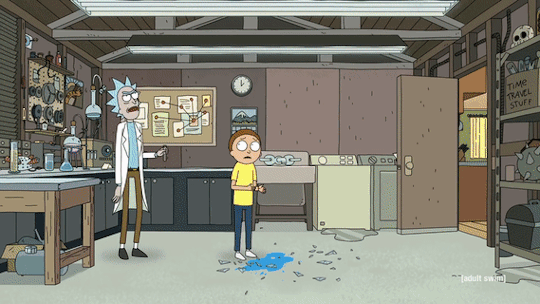
It’s an extremely successful and exciting animated piece, not only in getting fans to watch the new series - but also in attracting new ones. The show is renowned for it’s brilliant writing and sci-fi humour, not for it’s jaw-dropping animation. Trailers like this effectively celebrate the medium, and get people who would ordinarily overlook such a ‘crude science fiction cartoon’ to take another look at the show. The brilliant animation and experimental approach this trailer takes, like Toonami’s example, results in a praise and acclaim from a wide array of audiences, both fans and newcomers alike.
The animation boasts an impressive range of styles and endlessly imaganitive ideas towards transitioning between each new sequence. The movement is beautiful and exciting, fluid and dynamic as a whole whilst also allowing each individual sequence to have it’s own aesthetic and appeal. I would say this is more imaginative and exciting than the Toonami example, however there are still a few times where we simply flash to white and then the next sequence begins, or the transition animation doesn’t really blend with the next one. Ultimately, though, this is all rectified by the loose narrative the story has already established - Rick and Morty are effectively tripping on pure LSD in this sequence, so nothing really has to make sense - it’s a surreal, vivid and fantastic work of visual art.
We warp from a hand-drawn style, with an appealing chatter to a digital anime-like aesthetic, with exciting motion lines emphasising a dynamic sense of movement and action. Next, the viewer jumps into a very bizarre sequence, as a digitally drawn Rick and Morty are thrown into our world - an exciting motion capture animation, something I want to explore as a process. The blend of cartoon and real world is an idea that I think has lots of potential, from the subtle bobbing of the camera when Morty stands up to the accurate illusion of him sitting down on the park bench. The movement and interaction between the two worlds really works to create a believable sequence and harmonious blend of animation and reality. The wider range of animation styes and techniques allows the piece to feel more experimental, vast and rich in comparison to Toonami’s mostly 2D example.
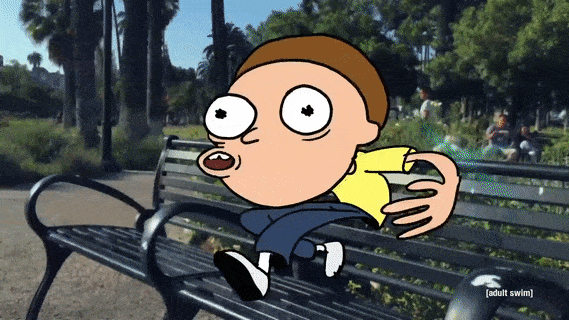
On a whole, the transitions between each sequence are much more creative and exciting than Toonami’s example, instead of blurs and zooms, we get warped transformations - with film frames shapeshifting into crisp comic panels, and then transforming into art pieces at a gallery. Each animator brings their own personal style to the table, from digital 2D to a cut out animation reminsciennt of Terry Gilliam’s surrealist works, but applied to a traditional acrylic painting.

Where Toonami’s example features an almost blink-and-you’ll-miss-it pace with a breakneck sonic soundscape, Rick and Morty’s Exquisite Corpse benefits from a slightly slower tempo and heavy, synthetic atmospheric beats allowing the sequences to run longer and breathe a little. These slightly longer sequences allow the audiences to appreciate and enjoy each animation more, I think, and allows each artist a much-needed breathing room. The range of techniques and styles also allows the animation to have a fluidity, not just in terms of aesthetic but also cinematography, with dynamic and spinning camera work that gives the animation an energetic quality and depth not usually seen in the show itself.
It’s a breath of fresh air compared to the standard flash-style animation of the show - a brilliant ‘collaborative cocktail’ of animation and imagination celebrating the endless possiblities of the medium.
Again, however, it seems like there’s a reluctance to explore stop motion or even digital 3D - like Toonami, the piece puts a heavy focus on 2D animation. I would say it does take more risks in this area than Toonami, but the sequence could be even more experimental and rich with techniques and visual language had the creators explored a more varied style. This would create a more difficult challenge for the animators, but I think it’s definitely something that would improve the success of the animation as a whole.
I think some of the most important ideas and principles to take from looking at this are the way the sequence quickly sets up a logical narrative reasoning for the lucid visuals, and the creative and endlessly imaginative approaches animators took when seamlessly transitioning from the previous artist’s sequence to their own.
Also, the blend of animation and our real world is an idea that I’ve mentioned already on the blog - but it’s something that I do find really interesting and marks an exciting challenge for me as an artist. As a process and technique, it’s something that I’d like to explore in the coming weeks.
The stop motion sequence transitions to the next, a 2D animated example, through a swirling of colour - the next sequence spirals onto the screen. These two examples, Rick and Morty and Toonami, represent one potential approach to an animated exquisite corpse - creating individual animated sequences with their own backdrops and transitioning from there. As I’m about to explore with Mugen’s Walk Cycle, however, this is just one of many. I think transitioning from entire sequences to just an animated character is somewhat easier - when you animate just the character, you’ve got to physically transform that character into the next one - a difficult task considering stop motion puppets into flat 2D illustrations. The final example I’m looking at, Mugen’s Walk Cycle, is a more stripped down, simplistic approach to this type of animation - something that relates to my own project quite nicely.
Based in London, freelance animator and visual artist Oscar Barany worked on the character animation and design of a music project titled Mugen, a Leeds based collective exploring the fictional character of the same name. Mugen is the animated character persona of indie musician Harry Kinchington, who produces all the music for the project. Barany has made several animated music videos and illustrations for the project, but it’s the vivid flashing walk of It Never Ends that I’ll be discussing here.
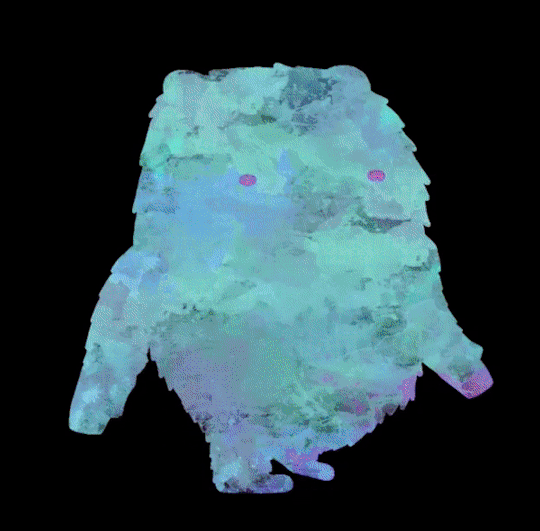
It Never Ends. (2017). Oscar Barany. Mugen.
Essentially a one-man animated exquisite corpse, it’s a looping walk cycle animation of Mugen, flashing between different character designs with every frame. These character designs, like Rick and Morty’s transitions, are endlessly imaginative, with the character shifting from an abstract set of geometric shapes or lines to a fez-wearing blue genie. The richness of the animation arises through these extremely engaging and creative character designs, instead of an experimental animation showcase. A vastly different approach to the previous two, this animation represents an interesting alternative to the fluid examples I’ve discussed already. The simplistic edge to the work results in a fun, engaging and naive animation with Oscar’s rather intuitive process and signature ‘jiggly monster’ aesthetic.
What Barany seems to have done here is create a digital frame by frame walk cycle with an outline template, and then created a new character design for each frame of animation. He’s an artist who loves working within Photoshop, so it’s likely he’s done the same here. The animation itself is deceptively simple in comparison to the other examples, but it’s Barany’s countless exciting and dynamic character designs that flash onscreen that makes the sequence so successful, fun to watch and weirdly addicting. The designs flash on and off screen so fast that it demands you pause and examine every frame, taking in each imaginative and bizarre illustration.
Although not strictly an ‘exquisite corpse’, I felt this example provided an interesting counterplay to the other examples I’ve discussed. As there’s no incredibly experimental or lucid, fluid movement, the animation puts the audience’s focus on the action at hand. In this case, it’s a character walking. This idea of a theme, and running idea between each sequence could be considered to be lost in Rick and Morty’s example, as there’s no real theme to the animation other than some surreal acid-soaked visuals. The same is true with Toonami’s Exquisite Corpse, which has no thematic idea or concept other than a space adventure. Barany’s example, however, has a clear concept and runs with it - there’s a theme that allows the animation to be somewhat restricted in comparison to the dimension-hopping antics of Rick and Morty.
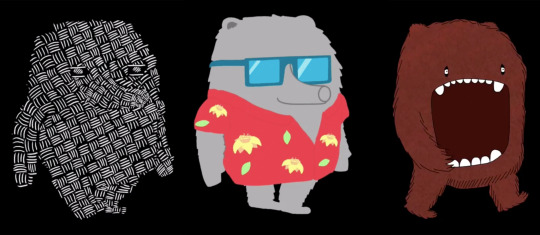
Although the piece doesn’t explore alternate mediums, such as stop motion or vastly different aesthetics, I think the sequence benefits from that simplicity and creative limitation. It’s a simple animated piece which speaks for itself through an exciting handful of imaginative and visually exciting character designs and a lively guitar soundtrack, with spacey and nuanced vocals that give the sequence a very atmospheric loose and wierdly nostalgic vibe.
An exquisite corpse is defined as a creative method in which a collection of works or images are collectively assembled, normally around an idea or theme. With that definition, I would say Barany’s walk cycle here fits the bill - through the shifting character design variations which have no real connection to the previous ones. It’s an animation that sings creativity and fun, with an appealing naivety that gives the work a simplistic charm.
I would discuss how Oscar decided to transition between each sequence, but here there’s no need for one. The electricity and fun quality of the animation arises from the flashing on and off screen of exciting, interesting character design variations on Mugen. There are no transitions, just simply flashes which really work in the animation’s favour, enhancing the piece’s naive appeal and again, finding a charm in simplicity.
I think if I were to simply stick to a flat 2D process, as this example does, this is something that I would want to use in creating a final piece. However, I want to explore stop motion animation in addition to 2D, so this template technique wouldn’t really work in the same way. Despite this, I will be exploring the process as a practical response to this research and as an experiment, looking at a different approach to creating an Exquisite Corpse-style animation which ditches the surrealist approach to narrative for a frankenstein’s monster of character designs and showcase of more traditional animation.
In this post, I’ve discussed a few different examples of an ‘exquisite corpse’ in my chosen specialist area of graphic arts, animation. These animations provide interesting approaches to the parlour game, both collectively assembled and a strictly solo project. I’ve been able to explore how these examples approach transitioning between animated sequences, and looked at an alternative approach that’s less surreal and absurd in it’s imagery in favour of a more linear animation. All of these examples are successful, but they could all benefit from a wider exploration of techniques and mediums, I think.
As I shift focus into experimenting with different animation techniques and processes, I’ll be beginning to consider how I can collate these sequences into a singular piece, and I’ll be taking the ideas discussed here and exploring these in how to transition from each animation. Moving forward, I want to explore Barany’s minimal approach through the digital template technique, designing a character and sketching out bizarre variations before jumping to the animation process. I’m planning on contacting the artist, and asking him to talk about his process as a way to gather my own primary artist research.
My direct next task will be to complete a mid-project review, reflecting on my progress so far in my FMP, looking at the skills I’ve learnt, difficulties encountered and an overall review of my work so far.
Actions
Write a Mid-Project Review, reflecting on my progress and tutor assessment
Produce a flashing walk cycle, inspired by Oscar Barany’s Mugen example
New References
Exquisite Corpse. (2017). Alex Tysowsky
It Never Ends. (2017). Oscar Barany. Mugen.
Exquisite Corpse. (2017). Matt Taylor.
0 notes